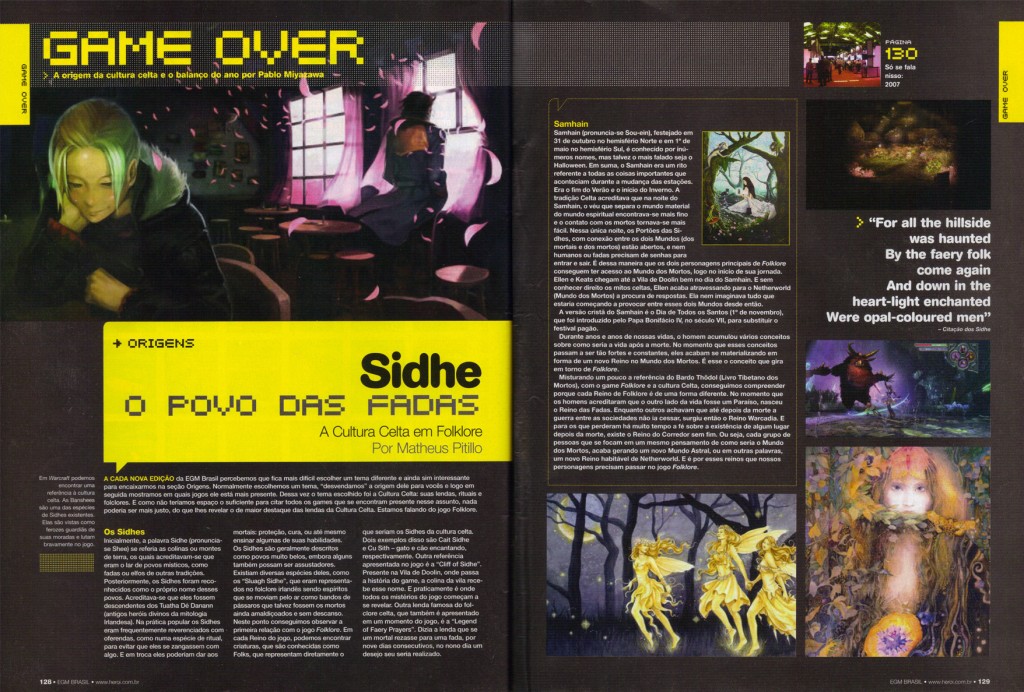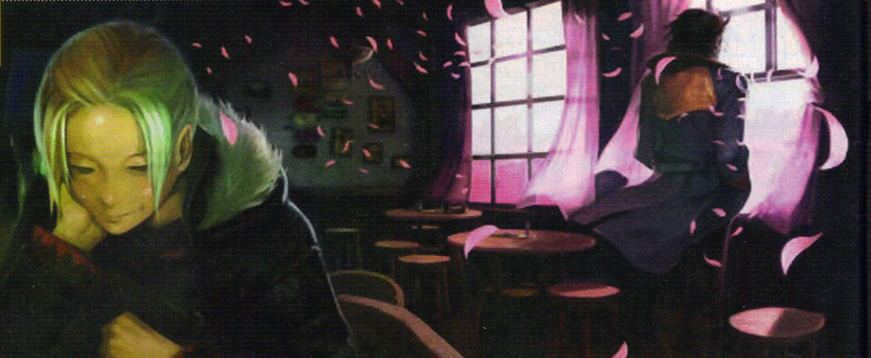The Celtic Culture in Folklore
Also published in EGM Brasil #71
With each new edition of EGM Brasil, we realize is more difficult to choose a different theme and still interesting to fit in the Origens section. Usually we choose a theme, "find" its origin and then we show in each games they are more present. This time the choosen theme was the Celtic Culture: your legends, rituals and folklore.
And how we will not have so much space to compare with a lot of games which could be present in this subject, nothing is more fair to reveal the one which has more spotlight in the Celtic Culture legends. We are talking about the game Folklore.

Original Publication in EGM Brasil Magazine
The Sidhes
At first, the word Sidhe - pronounced Shee - meant the hills or mounds of earth, who people believed that was home of mystics people, like fairies or elves of other traditions. Later, the Sidhe were recognized as the very name of these people. It was believed that they were descendants of the Tuatha De Danann - Ancient divine heroes of Irish mythology. In popular practice the Sidhes were often revered with offerings as a kind of ritual, to prevent them cheated on something. And in return they could give to mortals protection, healing and even teaching some of his skills.
The Sidhe are often described as very beautiful people, although some can also be scary. There were several species of them, like "Sluagh Shide", which were represented in Irish folklore as spirits that moved through the air like flocks of birds that might be the dead cursed and still restlessly. At this point we can observe the first relationship with the game Folklore. In every Kingdom of the game, we can find creatures - which are known as Folks - that directly represent what would be the Sidhe of Celtic Culture. Two examples are Cait Sidhe and Cu Sith - enchanted cat and dog, respectively.
Another reference appears in the game is the "Cliff of Sidhe". Present in the Village of Doolin, where is the story of the game, the hill gets its name from the village and is where almost all the game's mysteries start to reveal. Another famous legend of Celtic folklore, which is also presented in a moment of the game, is the "Legend of Faery Prayers". The Legend have said that if a mortal prays for a fairy for nine consecutive days, in the ninth day, one of his desires would be accomplished.
In Warcraft you can find a reference to Celtic Culture. The Banshees are one of the existing species of Sidhe. They are seen as fierce guardians of their homes and fight courageously in the game.
Samhain
Samhain - pronounced Sou-ein - celebrated on 31 October in the Northern Hemisphere and on the 1st of May in the Southern Hemisphere, is known by many names, but perhaps the most famous is Halloween. In short, Samhain was a ritual related to all the important things that happened during the changing seasons. It was the end of the Summer and beggining of the winter. Celtic tradition held that on the night of Samhain, the veil that separates the Material World from the Spiritual World found itself thinner, and the contact with the dead became easier. In that single night, the gates of the Sidhe, with connection between the two Worlds are open and not human or fairy require passwords to enter and exit.
This is how the two main characters in Folklore able to access the Underworld at the outset of his journey. Ellen and Keats reach the Village of Doolin exactly in the day of Samhain. And without knowing the right Celtic myths, Ellen ends up going through to the Netherworld in search of answers. She did not realize all that was starting to cause between these two worlds since then.
The Christian version of Samhain is the All Saints Day - 1st November - which was introduced by Pope Boniface IV in the seventh century, to replace the pagan festival. For years and years of our lives, the man has accumulated a number of concepts about what life was like after death. At the time that these concepts are so strong and constant, it is believed that they eventually materialized in the form of a New Kingdom in the Underworld. This is the concept that revolves around the game Folklore. Mixing a little reference to the Bardo Thodol - Tibetan Book of the Dead - with the game Folklore and Celtic Culture, we understand why every Kingdom of Folklore is a different place than before. At the moment men believed that the other side of life were a Paradise, the Kingdom of the Fairies was born. While others thought that even after dead, the war between the society prevailed, was borned then the Kingdom of Warcadia. And for those who long ago lost faith on the existence of somewhere after death, there is the Kingdom of the Endless Corridor. That is, each group of people who focus on one thought of how it would be the World of the Dead, it generates a new Astral Kingdom, or in other words, a New Kingdom of Netherworld habitable. And it is for those Kingdoms that our characters need to go in the game.
"For all the hillside was haunted
By the faery folk come again
And down in the heart-light enchanted
Were opal-coloured men".
[button type="icon" icon="paper"]Written by Matheus Pitillo.[/button]


Eu considero este um dos trabalhos mais geniais que já vi.
You’re blogging has really come on when I look back over previous posts. Actually I arrived here from a forum on an unrelated topic. Worth surfing sometimes. Thanks.
Pretty good article. I just stumbled upon your blog and wanted to say that I have really enjoyed reading your blog posts. Any way Ill be coming back and I hope you post again soon.
Great joob, just good stuff when is about Matheu’s work… keep going my friend….